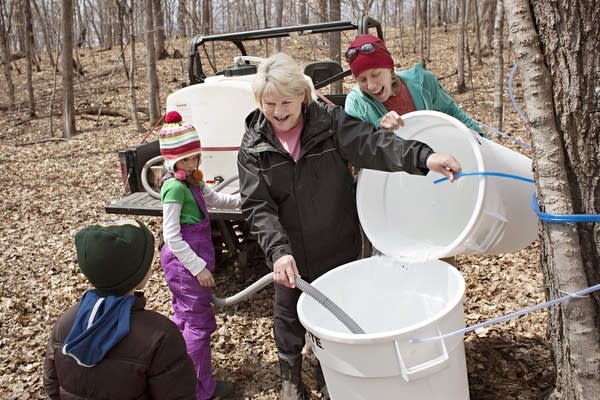Sap, short season keep Minnesota's maple syrup makers running in the spring

Go Deeper.
Create an account or log in to save stories.
Like this?
Thanks for liking this story! We have added it to a list of your favorite stories.
It's a crisp spring morning and sunshine warms the trees. Conditions, finally, are perfect for the maple sap to flow on Stu Peterson's farm.
There haven't been many perfect days this spring.
"Horrible," says Peterson as he works to cook down about 350 gallons of sap from what he calls sugar bush -- a stand of sugar maples where he and his wife, Corrine, gather and process the clear fluid into golden syrup. "This has been very late, very slow."
Peterson hopes his 15th maple syrup season will be somewhere between the worst and best. The cold weather this spring is slowing syrup production. A mix of warm days and cold nights are needed to get the sap flowing.
Turn Up Your Support
MPR News helps you turn down the noise and build shared understanding. Turn up your support for this public resource and keep trusted journalism accessible to all.

Video of sap flowing at Camp Aquila on Star Lake near Maplewood State Park in rural Minnesota. (Ann Arbor Miller / For MPR News)
Minnesota officials proclaimed March and April this year as the state's "maple syrup months." Proclamations, though, can't control the weather, which needs to be close to ideal to make the sap run. Minnesota marks the western edge of maple syrup production in the U.S. Those who tap the trees here must live with the uncertainty of a Minnesota spring.
"Two years ago was our worst ever. We made 40 gallons of syrup, which is nothing," said Peterson, president of the Minnesota Maple Syrup Producers. "Last year was our best ever, we had the same number of taps out and we made 300 gallons of syrup."

Turning the sweet, clear sap into sweeter golden brown syrup is part science, part art as Peterson showed on a visit to his farm about 60 miles southeast of Fargo-Moorhead.
A wood-fired cooker two-and-a-half feet wide and 8 feet long must be fed several chunks of wood every 10 minutes. Boiling sap moves through a series of shallow pans, getting thicker as water boils away leaving sugary syrup behind. This cooker can process about 65 gallons of sap per hour.
It typically takes about 40 gallons of sap to produce a gallon of maple syrup. "We should do pretty well this year, probably 35 to one or better," Peterson said. "The textbooks all say 40 to one, but we were running real high sugar on the sap we brought in yesterday -- unusual, but very good."
When the sap thickens to about two thirds sugar, it can be called syrup. As the sap gets thicker, it boils at a higher temperature. Weather conditions like temperature and barometric pressure can also affect the boiling point.

A temperature probe in the syrup pan is connected to an automatic valve. When the syrup hits the target temperature Peterson has set, the valve opens and syrup flows into a five-gallon jug.
"If I've done it right, I'm pulling it off just before the concentration of 66.5 percent sugars," he said.
After the sap run is done for the year, this syrup will be boiled once more on a stove to fine tune the sugar content before it's bottled and delivered to local stores and a couple of Twin City locations.
When this batch is cooked, Peterson hops on an ATV with a plastic tank on the back and heads into the woods to collect more sap. Corrine follows on a second rig.
Miles of blue plastic line stretch among the maple trees like giant translucent spider webs. Sap from a dozen or more trees flows into a large white container. A small pump sucks the sap out of the barrel into the tank on the ATV.
There are more than 1,300 taps collecting sap into about 50 of the big white barrels.
"Look at that stuff go. Woo Hoo!" Corrine says as she prepares to pump the sap from a container. "They're running rather than dripping."
The sap's running clear, so it will still cook into sticky sweet syrup. Once the trees start to bud or temperatures get too warm, the sap chemistry changes and so does the taste. Too warm and the sap will go bad, much like sour milk.
The Petersons head off into the woods, hoping to collect hundreds of gallons of sap before the weather turns warm, and this too-short maple syrup season ends.







